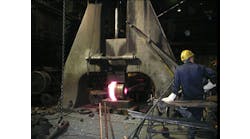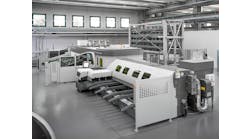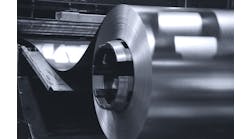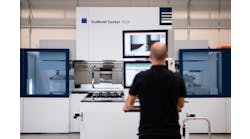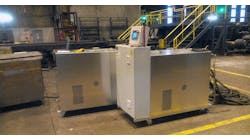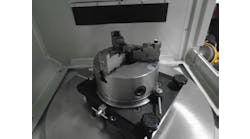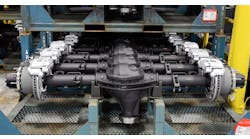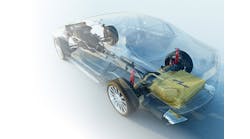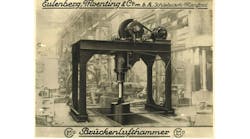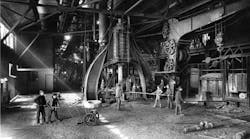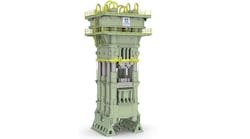Latest from Metal Forming
The Forging Industry Association (FIA) celebrates its centenary in 2013, 100 years of remarkable change for the forging industry.
When the Association started, forging was more of a craft than an industry, and even now it is frequently described as “heating and beating.” But in fact, the metallurgy and engineering of forging have evolved to encompass various sophisticated processes involving computer modeling, PLCs, exotic materials, and other state-of-the-art methods for developing net-shape finished products.
How did we get here? The FIA archives highlight numerous innovations prior to World War II that shaped the modern forge shop.
The Ancient Art
The origins are ultimately obscure, but forging can be traced to the intersection of fire and metals. With the mastery of both, it was not long before ancient people attempted to heat metallic compounds and pound them into simple shapes, for hunting, fighting, and later farming.
Most famous of early forgings are the Toledo blades, fired in Spanish territories from natively produced steels considered superior to those of other lands. More than 2,500 years ago, Iberian blacksmiths were forging uniquely designed, high-quality swords. The quality was such that users included Hannibal: Defeated at the point of those weapons, Roman legionnaires would also become customers.
Though forging was an art, primarily, the way it was done centuries ago incorporated some unique methods to ensure quality and repeatability. From antiquity through to the Middle Ages, in order to determine the correct time to place a sword blade in a furnace, blacksmiths would recite prayers and psalms in rhythm.
Improvements in chemistry brought stronger materials and refined means of production. Family and regional recipes for metallic compounds, as well as firing and hammering times, yielded more scientific expertise during the Industrial Revolution.
Many inventions of the Industrial Age depended upon forgings, including the cotton gin, locomotive, sewing machine, textile machinery, reaper, and artillery.
Until the mid-19th century, most forging works employed a flat hammer and die faces with simple impressions. Tilt hammers used for big jobs consisted of a beam with a weight on one end and pivoted in the middle. The weighted end was lifted by water working through a crude ratchet and fell free as the ratchet cleared the beam. Smaller jobs were performed using the English Oliver, an upsetting machine operated by human foot power.
According to contemporary reports in early-20th Century trade journals, the first breakthrough in industrial forging was precision forging dies, developed at the forge shop of Samuel Colt. This innovation enabled high-speed production of duplicate interchangeable parts.
A second breakthrough was the invention of the steam drop hammer, patented by James Nasmyth in 1847. Nasmyth’s original patent drawing hangs now in FIA’s headquarters. The 1860s brought another American invention, the board drop hammer, followed by the hydraulic forging press in the 1880s.
With these developments, blacksmithing—America’s first industry—gave way to drop forging, involving machines designed with a guided weight pulled up on a rope and then dropped on dies to shape heated metal alloys. Advancements in chemistry and alloy production in the late 19th century, along with the invention of more sophisticated hammer technology, are the seeds of today’s modern forging industry.
In a 1921 publication, What is a Drop Forging? (and Why People Care?), the American Drop Forging Institute boasted: “The development from the crude iron of ancient times to the perfected Bessemer, open-hearth and electric-furnace steel of today, has made possible our railroads, steamships, automobiles, tractors, farm machinery—every one of our modern necessities and comforts in business and home life.”
Harnessing Energy
Proceedings of the American Drop Forging Assn. (the organization that would become today’s FIA) detail technology innovations. For example, ADFA conferences in the 1910s focused on advances in electric motors and applications in the forge.
At the time, the industry debated whether the flexibility of individual machine drives and motors outweighed the efficiencies of a group drive, where several machines linked to a single driveline. The problem with a group drive: a motor failure would disable many machines at once, while a motor failure on individual machine drives would take down only that single unit.
During World War I, energy savings emerged as an industrial concern. Once a low-cost resource, scarce fuel supplies, and transportation difficulties made energy difficult to procure at almost any price. ADFA meetings and presentations focused on methods to use less energy and maintain reliable, less costly supplies. Also, the new process of thermite welding, used commonly in later years for railroad-track joining, was a hot topic in the 1910s.
The association chronicled industry news, events, and technology in its own magazine, American Drop Forger. In the August 1916 issue, "The Importance of the Keller Automatic DieSinker to the Drop Forge Industry", described what was essentially an automatic milling machine supplied with a hand feed. The machine addressed the lack of skilled human die-sinkers (even then, the lack of skilled workers was a hot topic, driving innovation), and promised a series of benefits related to automation.
“Undoubtedly, there will, for a time, continue to be some skepticism, as there always is to a new labor-saving method,” the article concluded, “but the fact is that thousands of dies have and are being produced by this method.”
By the early-1920s, forgers were poised to capitalize on tremendous technological advances that had occurred over only a few decades. These included a rise in the use of dedicated upsetters and forging machines, and in the development of furnaces.
One critical factor to heating advances was the arrival of fully automatic, electronically ignited oil burners in 1917: this spelled the decline of the dirty, laborious, and inexact process of starting and tending coal and wood fires. Instead, operators needed only to set a thermostat.
“More advancements have been made in the last five years in the construction of furnaces than from the time of the Village Blacksmith as immortalized by the poet, Henry W. Longfellow, to this particular date,” noted Dr. W.N. Best in his presentation, Illustrated Lecture on Modern Furnaces Using Oil as Fuel, at ADFA’s Annual Convention, in 1920.
“Oil as a fuel is a necessity in drop-forge plants, for by its use you can increase your output 100%. Your dies last longer, and you have every advantage over your competitor who uses coal as a fuel because of greater and superior quality of output.”
Advancements like this transformed the industrial landscape after World War I. “If one were to plot a diagram of human progress, with centuries for abscissa and important discoveries and inventions for ordinates, the resultant curve would rise but little until after the eighteenth century.
It would then sweep gradually but firmly upward until 1900, when it would mount sharply and with a sustained abruptness,” claimed an industry professional in the January 1922 issue of Forging and Heat Treating. “I would rather purchase a drop forging plant today than at any other time during our most recent history.”
Supplying Modern Society
Growth continued through the 1920s as the forging industry adapted to peacetime needs. An increasing population demanded more goods and services, with transportation, oil-and-gas, and construction industries needing forgers’ products. Electrification also benefitted forgers, with the process in high demand to meet electrical equipment and line-pole needs. Old ways rapidly gave way to new, forever changing the perception of forgers as blacksmiths.
For example, in a 1928 speech, one forger recounted: “I have just returned from a vacation on the eastern shore of Chesapeake Bay, near the small town of St. Michael’s,” he began to describe meeting a blacksmith of the horseshoe and wheelwright variety.
“During one of our conversations he told me that in 1917 he shod 1,800 horses; in 1922, 884 horses; and in 1927, 218 horses and he doubts that he will shoe 100 horses this year.”
The 1930s saw expanding use of new alloys, courtesy of advancements in metallurgy. Aluminum, stainless steel, and brass were all incorporated into forgings during this period. Forging machinery also advanced between the World Wars, as explained in the September 1968 issue of Precision Metal by its editor, Philip R. Kalischer:
“Newer, faster, bigger machines were built,” Kalischer wrote.
“Included were bigger, more accurate, more sensitive steam and airdrop hammers. Bigger hot and cold headers with multiple stations and with more accurate wire drawing and cut-off equipment. Upsetters were improved and larger ones built. Mechanical presses grew to 6,000 and 8,000-ton giants and hydraulic presses were even larger.”
By the start of the Second World War, forging had matured from mainly a supplier to agricultural and horse-drawn-carriage makers to an industry that—with no exaggeration—would change the world during and after the hostilities.

